Is the Squier Classic Vibe ’60s Jazzmaster the offset guitar of your dreams, or does its affordability come with too many compromises? As a dedicated guitar player and content creator at guitarplayers.net, I purchased this Sonic Blue beauty with my own money to give you a completely unbiased, hands-on review. Forget sponsored fluff – this is about real player experience. After spending over 40 hours playing and analyzing this guitar, I’m ready to share whether this Classic Vibe Jazzmaster lives up to the hype and if it deserves a spot in your collection, especially when considering the allure of more expensive Fender Jazzmasters. Let’s dive in.
Squier Classic Vibe ’60s Jazzmaster: An Overview
The Squier Classic Vibe series has earned a reputation for delivering exceptional value, capturing the essence of vintage Fender designs without breaking the bank. The Classic Vibe ’60s Jazzmaster is no exception, aiming to replicate the iconic style and sound of the 1960s Fender Jazzmaster. Crafted in Indonesia, this guitar boasts features that appeal to both seasoned players and those new to the offset world.
| Feature | Rating (Out of 10) |
|---|---|
| Looks | 9 |
| Setup (Out of Box) | 3 |
| Feel | 8 |
| Sound | 9 |
| Value | 9 |
Pros:
- Fun and inspiring to play
- Distinctive and versatile Jazzmaster sound
- Stunning vintage aesthetics
Cons:
- May require initial setup adjustments
- Single-coil pickups inherently produce some noise
- Potential need for minor upgrades for optimal playability for some players
Interested in seeing and hearing the Jazzmaster in action? Check out the video reviews below for a comprehensive sound demo and closer look.
In-Depth Review: Unpacking the Classic Vibe ’60s Jazzmaster
Unboxing and First Impressions: A Rocky Start
My initial excitement upon receiving the Classic Vibe Jazzmaster was quickly tempered by a less-than-stellar unboxing experience. While the Sonic Blue finish looked fantastic at first glance, closer inspection revealed some issues. The fretboard was marred with glue residue and dirt, and a few small, though playability-innocuous, chips were present on the fretboard edge. A minor blemish in the finish further dampened the initial enthusiasm.
 Close-up of Squier Classic Vibe Jazzmaster pickups and body, highlighting the Sonic Blue finish and single-coil pickups.
Close-up of Squier Classic Vibe Jazzmaster pickups and body, highlighting the Sonic Blue finish and single-coil pickups.
These imperfections, while not catastrophic, were unexpected on a new guitar, especially one at this price point. However, the guitar’s overall feel and visual appeal were undeniable. Recognizing its potential, I contacted Musician’s Friend who were very helpful and offered a partial refund to compensate for the cleanup work required. I opted for the refund and decided to invest some time in bringing the Jazzmaster up to my standards.
Sound and Tone: Embracing the Jazzmaster Magic
Despite the initial setup issues, the sonic character of the Classic Vibe ’60s Jazzmaster quickly won me over. These Fender-designed single-coil pickups deliver the quintessential Jazzmaster tone – a unique blend of warmth, clarity, and a touch of grit. They are not P90s, but offer a distinct voice that sits somewhere between a Stratocaster’s brightness and a thicker, more rounded single-coil sound.
The Jazzmaster excels in a variety of genres, from clean surf rock and shimmering indie tones to more driven blues and alternative rock sounds. It handles fuzz pedals exceptionally well, retaining clarity while adding a pleasing harmonic complexity. While inherently noisier than humbucker-equipped guitars due to the single-coil design, the noise is manageable and, in my opinion, part of the instrument’s vintage charm. Unless you’re aiming for high-gain metal genres, the noise level shouldn’t be a significant concern. For those seeking to minimize noise, a noise gate pedal can easily tame any unwanted hum.
Playability and Feel: Getting Comfortable with an Offset
Once I addressed the initial setup issues, the Classic Vibe Jazzmaster proved to be a comfortable and enjoyable instrument to play. The neck profile is a comfortable “C” shape, reminiscent of vintage Fender guitars, making it accessible for various hand sizes and playing styles. The fretboard, after cleaning and polishing, felt smooth and responsive.
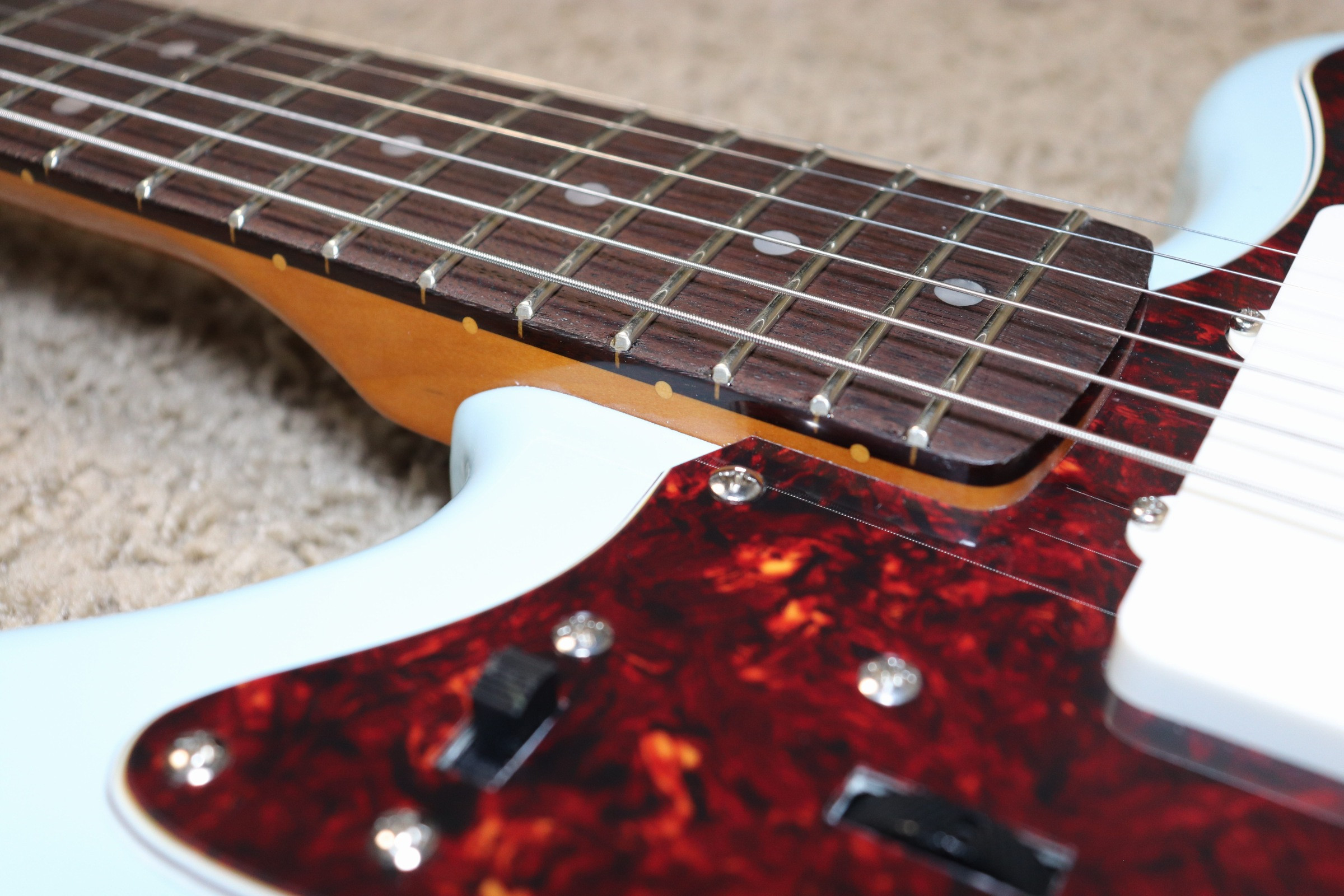 Photo highlighting the Jazzmaster's rhythm and lead circuit switch, showcasing the unique controls of this guitar model.
Photo highlighting the Jazzmaster's rhythm and lead circuit switch, showcasing the unique controls of this guitar model.
The 21 frets are well-dressed, and the vintage-style tremolo system adds another layer of expressive playing possibilities. While some players may find the Jazzmaster tremolo system a bit quirky compared to a Stratocaster trem, it offers a unique feel and contributes to the guitar’s overall character. The rhythm and lead circuits, a hallmark of the Jazzmaster, provide further tonal versatility, allowing for quick switching between different volume and tone settings.
Setup and Adjustments: Personalizing Your Play
As mentioned, the out-of-the-box setup was lacking. However, with a bit of effort, the Classic Vibe Jazzmaster can be transformed into a fantastic playing instrument. My setup process involved:
- Fret Cleaning: Carefully scraping glue residue from the frets.
- Fret Polishing: Using micromesh to polish the frets for smooth playability.
- Fretboard Conditioning: Cleaning and conditioning the fretboard with lemon oil.
- Neck Shim Installation: Adding a 0.5-degree neck shim to optimize the string break angle and improve playability. This is a common adjustment for Jazzmasters and can enhance the guitar’s overall feel.
- Bridge Height Adjustment: Raising the bridge to achieve the desired string height after installing the neck shim.
- Intonation: Setting the intonation for accurate tuning across the fretboard.
While some of these steps might seem daunting to beginners, there are numerous online resources and tutorials available to guide you through the process. Alternatively, a professional guitar setup from a local tech is a worthwhile investment to ensure optimal playability.
 Close-up photo of the Squier Classic Vibe Jazzmaster's lower body curve, showcasing the offset design and Sonic Blue finish.
Close-up photo of the Squier Classic Vibe Jazzmaster's lower body curve, showcasing the offset design and Sonic Blue finish.
Potential Upgrades: To Mod or Not To Mod?
The online guitar community is rife with discussions about “essential” upgrades for Squier guitars, including the Classic Vibe Jazzmaster. While some players advocate for immediate parts replacements, I believe the stock components are perfectly adequate for most players, especially at this price point.
Upgrades like locking tuners can simplify string changes, and pickup swaps can offer tonal variations, but these are not necessary to enjoy the guitar. I personally considered upgrading the tuners to locking tuners for convenience but found the stock tuners to be stable and reliable. Similarly, while aftermarket pickups could offer subtle sonic improvements, the Fender-designed pickups in the Classic Vibe Jazzmaster are already excellent and capture the essence of the Jazzmaster sound.
If you’re a beginner or intermediate player, I recommend spending time playing the guitar in its stock form before considering any upgrades. Get to know its nuances and identify any areas where you feel an upgrade might enhance your playing experience.
Video Review: Hear the Jazzmaster Roar
Words can only convey so much about a guitar’s sound and feel. To truly appreciate the Classic Vibe ’60s Jazzmaster, I recommend checking out these video reviews:
[Link to Video Review Part 1]
[Link to Video Review Part 2]
[Link to 45-Second Quick Review]
These videos provide a comprehensive sound demo, allowing you to hear the Jazzmaster in various playing contexts and showcasing the functionality of the rhythm and lead circuits. You’ll also get a closer visual inspection of the guitar and see it in action.
Who is the Squier Classic Vibe 60s Jazzmaster For?
The Squier Classic Vibe ’60s Jazzmaster is an excellent choice for guitarists who:
- Are drawn to the unique offset body style and vintage aesthetics of the Jazzmaster.
- Seek the distinctive single-coil Jazzmaster tone for genres like surf rock, indie, alternative, blues, and more.
- Are on a budget but desire a quality instrument that captures the essence of a classic Fender design.
- Are willing to invest a little time in setup and adjustments to optimize playability.
- Appreciate a versatile guitar with unique tonal options offered by the rhythm and lead circuits.
This guitar is particularly well-suited for beginners and intermediate players looking to explore the world of Jazzmaster Guitars without the hefty price tag of a Fender American Professional or vintage model. It’s also a great option for experienced players seeking a reliable and inspiring offset guitar for home practice, recording, or gigging.
Final Verdict: A Resounding Yes for the CV ’60s Jazzmaster
Despite a slightly disappointing unboxing experience, the Squier Classic Vibe ’60s Jazzmaster ultimately exceeded my expectations. With a bit of setup work, it transformed into a fantastic playing and sounding instrument that captures the magic of the Jazzmaster at an incredibly accessible price.
If you’re considering a Jazzmaster and want to avoid spending a fortune, the Classic Vibe ’60s model is a resounding “yes” from me. It offers exceptional value, delivering vintage vibe, distinctive tone, and enjoyable playability. While it might not be perfect straight out of the box, the minor issues are easily addressed, making this guitar a true gem in the budget-friendly offset market.
Overall Rating: 7.6/10 (Would be higher with better out-of-box setup)
Do you own a Classic Vibe Jazzmaster? Share your thoughts and experiences in the comments below!
Classic Vibe 60s Jazzmaster Photo Gallery
[Image grid of Jazzmaster photos as in the original article, with updated ALT texts below]
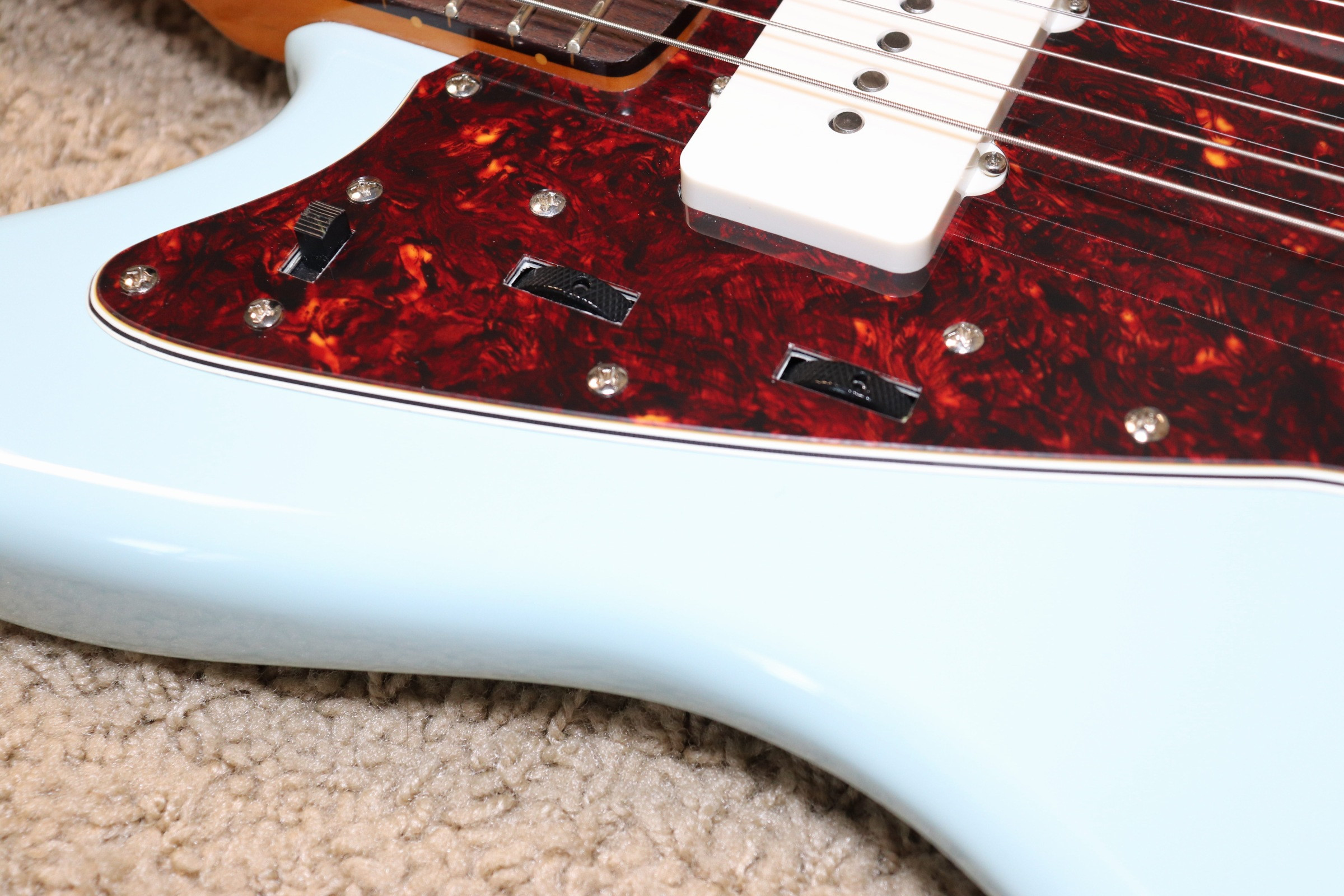 Close-up of the Squier Classic Vibe Jazzmaster headstock, showing vintage-style tuners and Squier logo.
Close-up of the Squier Classic Vibe Jazzmaster headstock, showing vintage-style tuners and Squier logo.
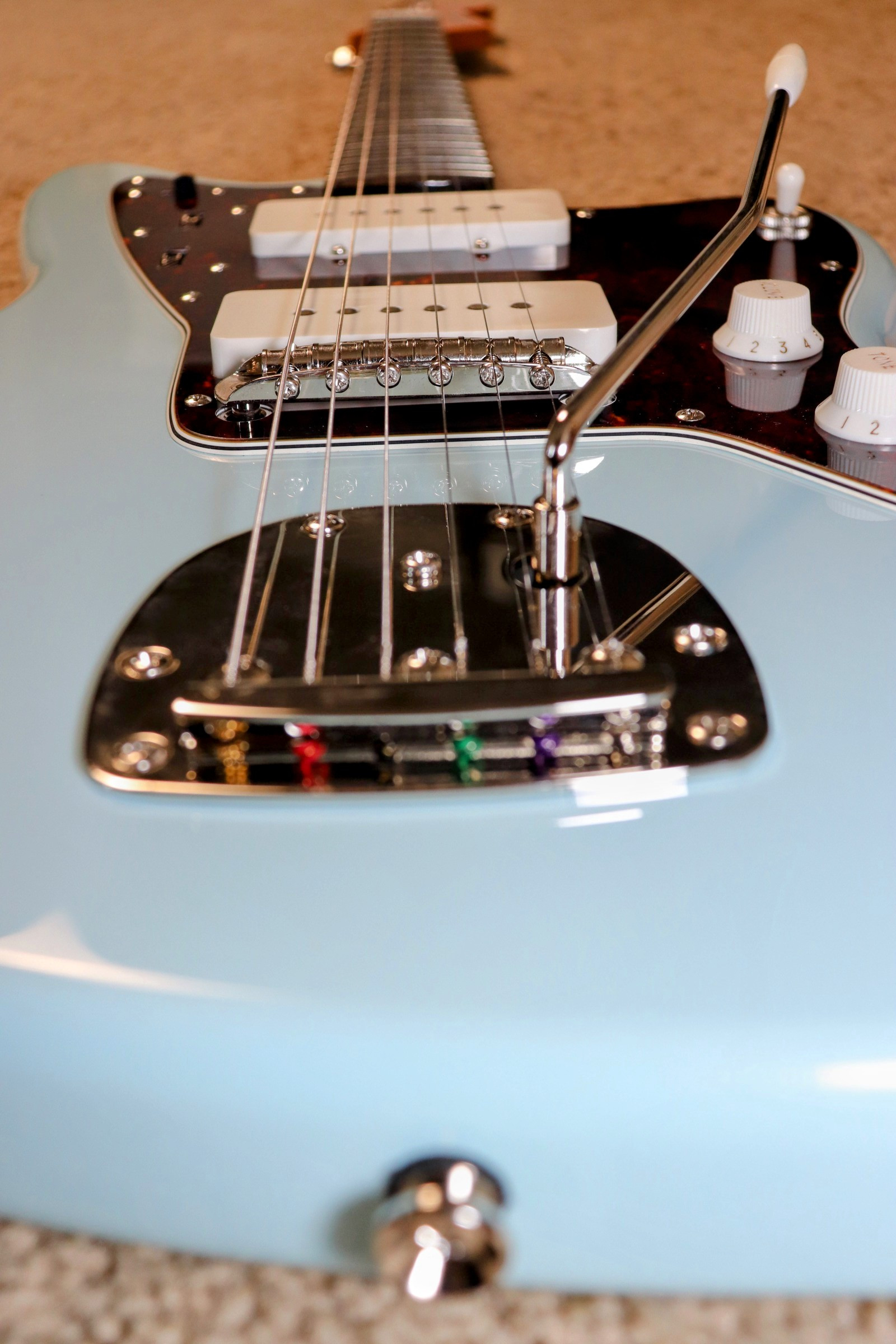 Angled shot of the Sonic Blue Squier Classic Vibe Jazzmaster body, emphasizing the offset contours and pickguard.
Angled shot of the Sonic Blue Squier Classic Vibe Jazzmaster body, emphasizing the offset contours and pickguard.
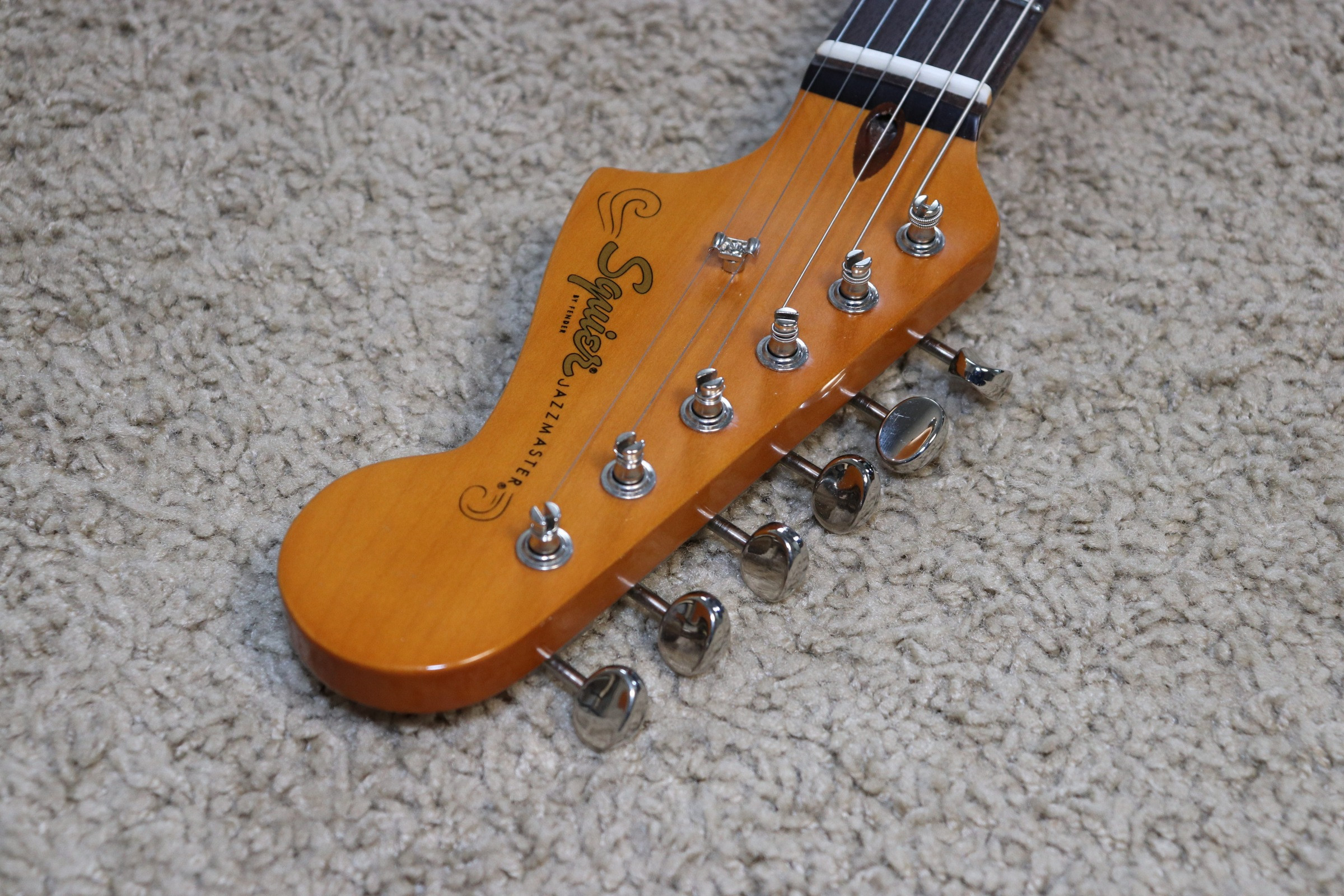 Full body shot of the Squier Classic Vibe Jazzmaster in Sonic Blue, showcasing its overall design and vintage aesthetic.
Full body shot of the Squier Classic Vibe Jazzmaster in Sonic Blue, showcasing its overall design and vintage aesthetic.
 Close-up of Squier Classic Vibe Jazzmaster pickups and body, highlighting the Sonic Blue finish and single-coil pickups.
Close-up of Squier Classic Vibe Jazzmaster pickups and body, highlighting the Sonic Blue finish and single-coil pickups.
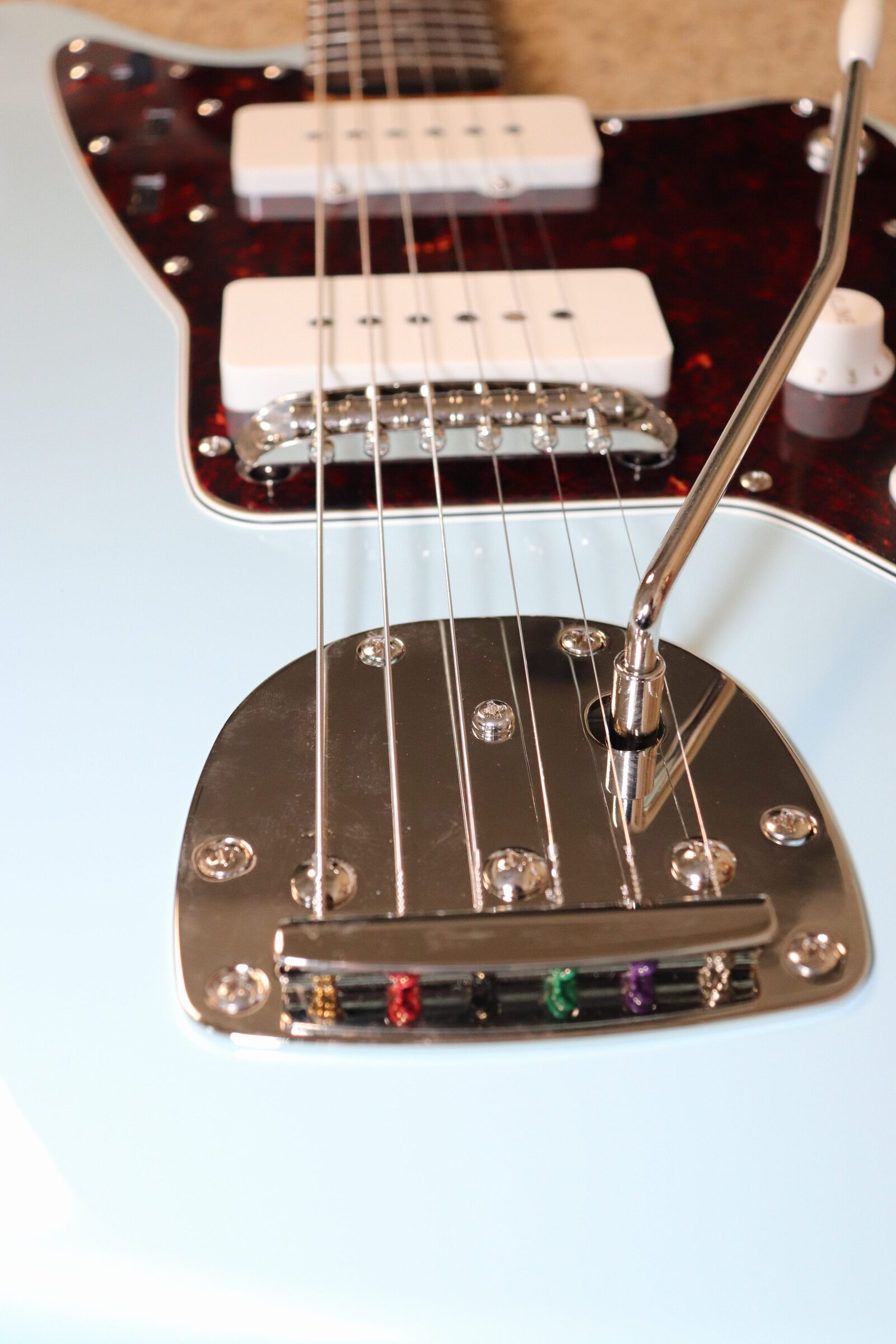 Side profile of the Squier Classic Vibe Jazzmaster body, showing the depth and curves of the offset design.
Side profile of the Squier Classic Vibe Jazzmaster body, showing the depth and curves of the offset design.
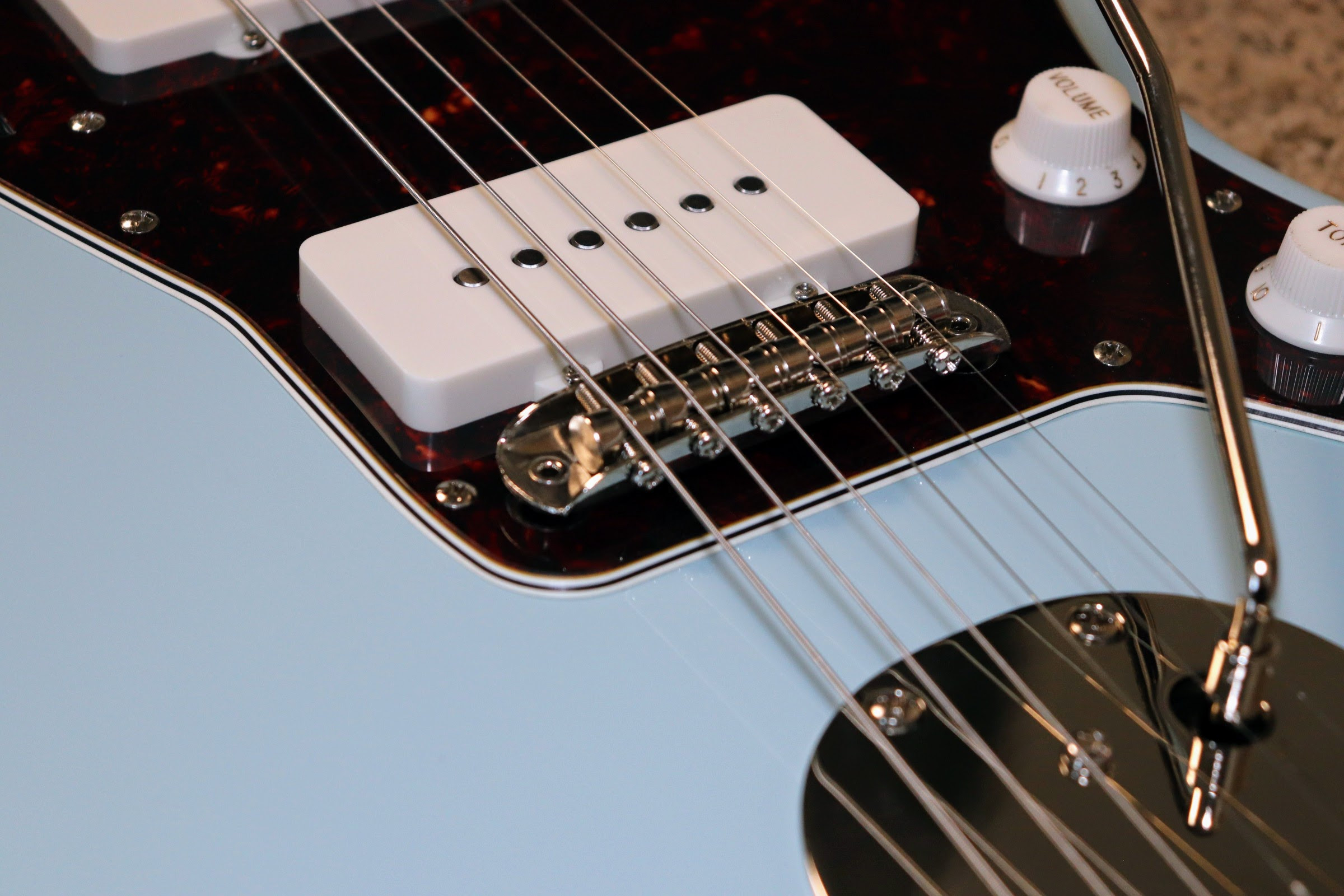 Close-up image of the Squier Classic Vibe Jazzmaster bridge and tremolo system, demonstrating the vintage-style hardware.
Close-up image of the Squier Classic Vibe Jazzmaster bridge and tremolo system, demonstrating the vintage-style hardware.

